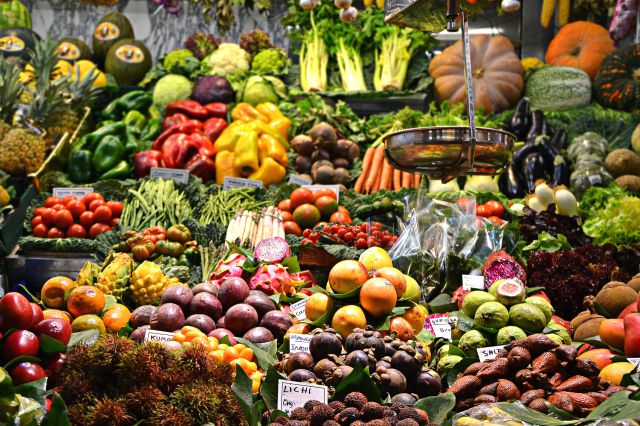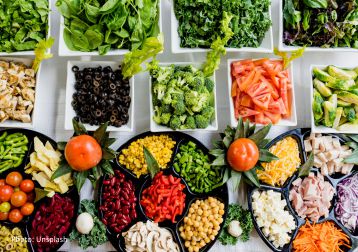
Food Waste

Food waste or food loss is food that is not eaten. The causes of food waste or loss are numerous and occur throughout the food system, during production, processing, distribution, retail and consumption. Global food loss and waste amount to between one-third[149] and one-half of all food produced. In low-income countries, most loss occurs during production, while in developed countries much food – about 100 kilograms (220 lb) per person per year – is wasted at the consumption stage.
Food waste is a major part of the impact of agriculture on climate change. and other environmental issues. The Food and Agricultural Organization estimated in 2014 that food waste lost causes a global economic, environmental and social cost of $2.6 trillion a year and is responsible for 8 percent of global greenhouse gas emissions. Moreover, food waste that is not handled or reclaimed properly, i.e. through composting, can have many negative environmental consequences. For example, landfill gas from anaerobic digestion of organic matter is a major source of the greenhouse gas methane, and un-reclaimed phosphorus in food waste, leads to further phosphate mining. Moreover reducing food waste in all parts of the food system is an important part of reducing the environmental impact of agriculture, by reducing the total amount of water, land and other resources needed to feed the global community.

The international community has identified reduction of food waste as an important part of developing a sustainable economy with Sustainable Development Goal 12 seeking to “Halve global per capita food waste”. Moreover, climate change mitigation strategies prominently feature reducing food waste; for example Project Drawdown describes reducing food waste as one of the more effective ways to reduce carbon intensity of the food system.

25 Food Curiosities
In recent years, more and more new foods are appearing on the market, and people are eager to taste them or even introduce them into their daily diet, even if they know nothing about them. It is important to document what you offer your body in terms of nutrition and, even if you can’t find out everything about every dish you eat, try to keep a healthy and beneficial diet for your body.
1. Chocolate was used by the Aztecs as a currency. The conquered tribes also paid tribute using cocoa.
2. Ketchup was used as a medicine in the 1800s to treat indigestion and other diseases.
3. Ice cream on a stick was invented by an 11-year-old boy in 1905.
4. The most expensive fruit in the world is a melon sold in Japan at auction for over $ 23,000.
5. One of the most moisturizing foods is cucumber: 96% water
6. The oldest evidence of the invention of the soup dates from the year 6000 BC. And it was cooked from hippo meat.
7. Peas are one of the most popular pizza toppings in Brazil
8. In 1889, the Italians invented the Margherita pizza. It is said that the name of the dish was given in honor of Queen Margherita.
9. Globally, about 30% of food is lost, food being thrown away. The food produced is enough for all people to eat to their heart’s content, but the distribution is to blame here, because the food does not always get where it is needed. Thus, a huge imbalance is created and so a family of 4 members ends up throwing away more than 800 kg of food, annually
10. Have you heard of square melons? Yes, there is, because the Japanese started growing melons in square glass containers to force them to take that shape. Logic? They are much easier to keep in the fridge, to cut and to serve, at the same time. Moreover, they are seen much faster than round melons!
11. Honey is the only food in the world that does not rot, it can be kept for up to 3,000 years, in good condition and edible.
12. Did you know that a person consumes around 30 tons of food in a lifetime?
13. The food that is served on the plane is not as tasty because the smell and taste decreases by up to 50% during the flight.
14. Eskimos use the refrigerator to heat food. Specifically, to prevent it from freezing.
15. Children are born with a great preference for sweets. Researchers attribute this to the fact that they are growing fast and need a lot of calories in order to grow. Sugar also makes them feel good.
16. Sometimes we crave certain foods depending on the mood of the moment. We eat fluffy foods in moments of peace, the sweet ones remind us of childhood, and the crunchy ones when we are a little stressed. French fries offer a little of each.
17. Due to their high water content and chemical composition, potatoes can absorb and emit Wi-Fi signal.
18. Most commercially available bananas are genetically identical because they come from virtually the same Cavendish banana tree, which has been cloned for several decades.
19. Bananas can help us fight depression.
20. The seed inside the peach kernel has a very strong anti-cancer substance called laetrile (vitamin B 17).
21. Apples float in water because a quarter of their volume is full of air
22. Researchers have succeeded in turning peanut butter into diamonds due to its high carbon content.
23. There are so many varieties of apples that it would take over 20 years for someone to taste them all, given that they would eat one a day.
24. Garlic chemicals are so strong that if a dog is left in direct contact with the skin for a long time, it can cause third degree burns.
25. Coconut water can be used as a plasma in case of absolute urgency.

What do you think about Food?
I believe that the most important aspect of the human-food relationship is not vitamins, nor minerals, nor enzymes, nor proteins, nor water.
I think the most important part of our relationship with food is what we think about food. What we think and feel when it comes to eating.
A man who is full and a man who is hungry will look at a full plate completely differently, will perceive a slice of bread totally differently, they will eat a slice of chocolate cake totally differently. And that’s absolutely natural, if you ask the brain. Two people will never see the same thing when they look at food and, more importantly, they will not metabolize it in the same way, they will not digest it in the same way.
Let me give you some concrete examples, so that you can begin to understand better:
Imagine a plate on which you see pasta, a grilled chicken breast and a salad.
- A woman interested in losing weight will see a danger, a threat, when she looks at pasta, because, no, we all know that flour makes you fat. She will choose the salad as a “rescue”.
- An athlete interested in “building muscle” will look at the same food and look for the source of protein. So, he will set aside the salad and the pasta and choose the meat.
- A vegetarian will not be thrilled to see chicken on a plate and may not touch any of the foods that may have come in contact with the meat.
- A farmer, animal breeder, carnivore by definition, will be happy to see such a beautiful piece of chicken.
- Someone suffering from a disease will see in the same plate, depending on the foods that are allowed in the diet related to the disease, or a source of health or, conversely, a harmful source, which could aggravate his suffering.
- A nutritionist will see a collection of chemicals, each with specific properties and fixed amounts of vitamins and minerals per hundred grams of food.
All this without the plate changing its composition or appearance!
What’s fascinating is that each of these characters listed by me will digest this food in a different way, depending on what they think about what they eat. In other words, what you think and feel about a food can mean as much or sometimes even more than what the nutrients themselves mean.
Yes, I know it may sound unbelievable, that’s why I’m helping science, my good friend:
In the body, there is a permanent connection between the brain and the digestive system, through the spinal cord and nerves.
Let’s imagine an ice cream.
The word “ice cream” and the image of an ice cream appear in the part of the brain called the “cerebral cortex”. From here, the information is passed on to the limbic system, where the main emotions and physiological functions are regulated: hunger, thirst, temperature, heartbeat and tension. Here, dwarf, there is a small piece of brain, the size of a pea, the hypothalamus, which turns what the mind “says” into actions performed by the body. In simpler words, the hypothalamus transforms thoughts, emotions and sensations into physical, physiological responses. You think of a lemon and you feel your teeth chattering, your mouth sneezing. There’s nothing paranormal about that. On the contrary.
If the ice cream you are thinking of is your favorite and, while eating it, you are happy, lustful, delighted, the hypothalamus will turn this positive thought into reactions in the salivary glands, esophagus, stomach, intestines, pancreas, liver and bile. . Digestion will be stimulated and you will have a broader metabolic response, ice cream “will not make you fat”, but will be digested, absorbed, “eaten” much more efficiently.
If, however, you feel guilty while eating it and condemn yourself to succumbing to temptation, the hypothalamus will take over this negative, frightening thought and send signals to inhibit the digestive organs mentioned above, so that this “dangerous” food does not it ends up being digested, metabolized. Than, possibly, to such an extent that we survive, but it will not be completely absorbed. Therefore, this undigested food will remain in the intestines for longer, will generate putrefaction processes, will cause toxins in the blood system, will alter the population of healthy bacteria. Moreover, due to the secretion of cortisol, the stress hormone, the efficiency with which the body burns calories from food is negatively affected and the body stores these foods in the form of fats. So, what you think about food immediately becomes a reality in your body, with the help of the central nervous system.
The brain does not distinguish between a real stressor and one that you can only imagine. If you sit on the beach, calm, happy and suddenly a song reminds you of your ex-boyfriend who left you, and this thought still has an emotional charge, your body will change in an instant – they will speed up your heartbeat, you will breathe faster, you will tear, your muscles will contract and, under these conditions, digestion will be inhibited, it will be adversely affected.
Any feeling of guilt over food or shame towards your body, any judgment about your health is considered a stress factor and the brain will automatically generate equivalent electrochemical reactions in the body. You can eat the healthiest food on the planet, but if you think badly of it, digestion can be inhibited and fat absorption metabolism can intensify, “gaining weight.” Likewise, if you eat any food, even one considered junk food or without high quality nutrients, but your mind and feelings towards this food are positive, fine, serene, the food will be perceived as “doing us good” and the body will act effectively.
The part that fascinated me the most throughout my study of feeding psychology is the placebo effect. One of the most irresistible effects of the brain on life, I might say.
In 1983, a study was done to test a chemotherapy treatment. One group with cancer received the drug, while the second group received a placebo, a salt water solution. Pharmaceutical companies are required by law to placebo test any new drug to prove its true effectiveness. Patients have been notified that their hair will fall out as a result of chemotherapy. In the group that received the actual drug, 74% of people lost their hair. In the second group, which received a saline solution, no one should have lost their hair, right? Eh, how about 31% of patients lose their hair? So great is the power of the mind. So great is the effect that our expectations can have. The effect of the brain on the body can be so mind-boggling. There is only one explanation for hair loss in the group of patients who did not receive chemotherapy: they thought they were they will lose their hair!
If your mind is able to make your hair fall out just because you expect it to fall out, what do you think it can do when you say to yourself, “This cake is going to make me fat, I really shouldn’t eat it!” Or “I want to eat this pizza, but I know it’s going to hurt” or “I really like this salad, because I know it’s super alive, super healthy!”
Of course, I’m not saying you can eat anything without anything happening just because you believe it’s good for you. I say, however, that what we think about the food we put in our mouths can strongly influence what happens in our body. Every day, millions of people drink and eat while having strong beliefs about their food and thoughts that affect their health.
source: M. Sisson

What kind of thoughts do you have when you eat?
“Sugar will ruin my teeth. I’m not so sure, but my child is for sure! ”
“This meat has a little fat and I’m going to gain weight even harder!”
“If I eat salty, my blood pressure will increase!”
“If I don’t drink my coffee, I can’t even get out of bed. If I don’t drink a second coffee, I can’t even read my emails. ”
“This mayonnaise is going to blow up my cholesterol!”
“Milk brings me calcium and orange vitamin C.”
To some extent, these claims could be true. But is it possible to potentiate or inhibit the effects of these foods just by changing our minds about them or what they can do to us?
Careful! Research has estimated that 35-45% of all medicines may be due to the effectiveness of the placebo effect. 67% of over-the-counter remedies, usually food supplements, do us good because of our belief that they will do us good, that they are more effective than chemicals, that they are less aggressive, with fewer side effects. In some studies, the placebo effect was 90% effective!
It surprises me that, while in the pharma industry, the placebo effect is frequently considered and widely used, in relation to food it is hardly considered at all. And, yes, believe me, its effects are amazing in terms of the relationship between man and his food. You know from the famous saying of Hippocrates, the father of modern medicine, “May food be your medicine and medicine your food.”
It’s like going to your own pharmacy, inside you, when you eat and think that the food will do you good, it will bring you health, healing. What we think about life, about food, about people is transformed into chemistry, into physical reactions, with the help of the senses, nerves, the endocrine system, neuropeptides, the immune system and the digestive system.
What are you going to tell yourself from now on when you sit down at the table?
I would love to hear your opinions. I would like you to send me phrases that you say when you eat, so that your brain can give commands that balance you, maintain your proper weight, grow your hair, make you big. Let’s think together what we should tell our children about food, so that we can build a lifelong friendship with food, so that their thoughts in the presence of food are always thoughts that give them strength, give them life.
source: M. Sisson

Nutritional support for an organism
Food is any substance consumed to provide nutritional support for an organism. Food is usually of plant, animal or fungal origin, and contains essential nutrients, such as carbohydrates, fats, proteins, vitamins, or minerals. The substance is ingested by an organism and assimilated by the organism’s cells to provide energy, maintain life, or stimulate growth. Different species of animals have different feeding behaviours that satisfy the needs of their unique metabolisms, often evolved to fill a specific ecological niche within specific geographical contexts.
Omnivorous humans are highly adaptable and have adapted to obtain food in many different ecosystems. Historically, humans secured food through two main methods: hunting and gathering and agriculture. As agricultural technologies increased, humans settled into agriculture lifestyles with diets shaped by the agriculture opportunities in their geography. Geographic and cultural differences has led to creation of numerous cuisines and culinary arts, including a wide array of ingredients, herbs, spices, techniques, and dishes. As cultures have mixed through forces like international trade and globalization, ingredients have become more widely available beyond their geographic and cultural origins, creating a cosmopolitan exchange of different food traditions and practices.
Today, the majority of the food energy required by the ever-increasing population of the world is supplied by the industrial food industry, which produces food with intensive agriculture and distributes it through complex food processing and food distribution systems. This system of conventional agriculture relies heavily on fossil fuels, which means that the food and agricultural system is one of the major contributors to climate change, accountable for as much as 37% of total greenhouse gas emissions. Addressing the carbon intensity of the food system and food waste are important mitigation measures in the global response to climate change.
The food system has significant impacts on a wide range of other social and political issues including: sustainability, biological diversity, economics, population growth, water supply, and access to food.
source: wikipedia.org
